5086 Aluminum Plate Sheet
Temper: H111/H116/H32 Certification: ISO9001
What is 5086 Grade Aluminum?
Aluminum grade 5086 is a high-strength alloy mainly composed of aluminum (AL), magnesium (MG), and manganese (MN). It belongs to the 5xxx series of aluminum alloys known for their excellent corrosion resistance, weldability, and moderate strength.
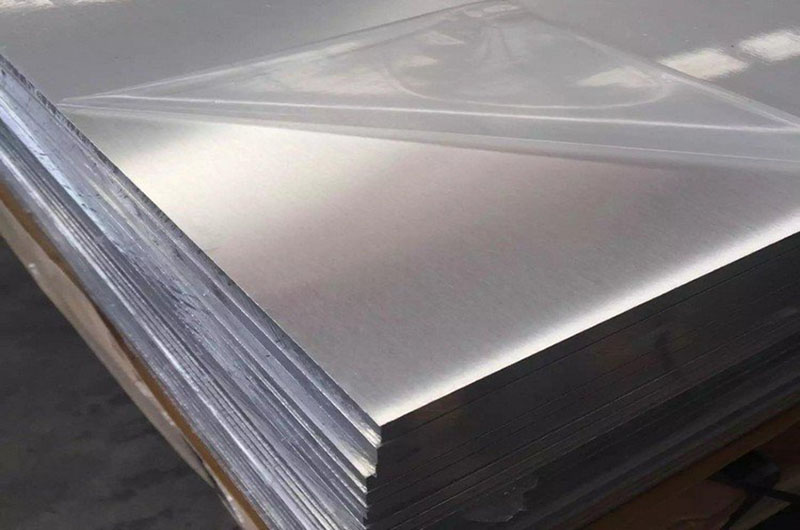
5086 aluminum alloy is not strengthened by heat treatment but becomes stronger through strain hardening or cold machining of the material.
Anti-rust aluminum plates include aluminum-magnesium alloy aluminum plates and aluminum-manganese alloy aluminum plates.
1. Aluminum-magnesium alloy aluminum plate
Representatives of aluminum-magnesium alloy aluminum plates are:
- 5005 Aluminum Plate
- 5252 Aluminum Plate
- 5251 Aluminum Plate
- 5050 Aluminum Plate
- 5052 Aluminum Plate
- 5754 Aluminum Plate
- 5083 Aluminum Plate
- 5056 Aluminum Plate
- 5086 Aluminum Plate
The order of aluminum-magnesium alloy according to the content of magnesium alloy is 5005 5252 5251 5050 5052 5754 5083 5056 5086 and so on.
2. Aluminum-manganese alloy aluminum plate
Representatives of aluminum-manganese alloy aluminum plates are:
- 3003 Aluminum Plate
- 3004 Aluminum Plate
- 3105 Aluminum Plate
5086 Aluminum Plate Properties
1. 5086 aluminum plate is highly corrosive in seawater
5086 aluminum has excellent corrosion resistance in a variety of environments, including seawater. This makes it suitable for marine applications such as hulls, decks, and other marine structures.
2. 5086 aluminum plate has high strength
5086 aluminum has good strength properties, making it suitable for structural applications requiring a high strength-to-weight ratio. It has a tensile strength of approximately 40, 000 psi (275 MPa) and a yield strength of approximately 35, 000 psi (240 MPa).
3. 5086 aluminum plate has good weldability
Because heat treatment does not strongly affect strength, 5086 is easily welded and retains much of its mechanical strength. Good welding results and good corrosion properties in seawater make 5086 very popular in ship ramps, shipbuilding, and yacht hulls.
5086 aluminum plate has excellent weldability and can achieve effective and reliable connections through various welding methods such as MIG (Metal Inert Gas) welding, TIG (Tungsten Inert Gas) welding, and resistance welding.
4. 5086 aluminum plate has good formability
5086 aluminum alloy can be easily formed and manufactured through common techniques such as bending, stamping, and rolling, allowing it to be formed into a variety of components and structures.
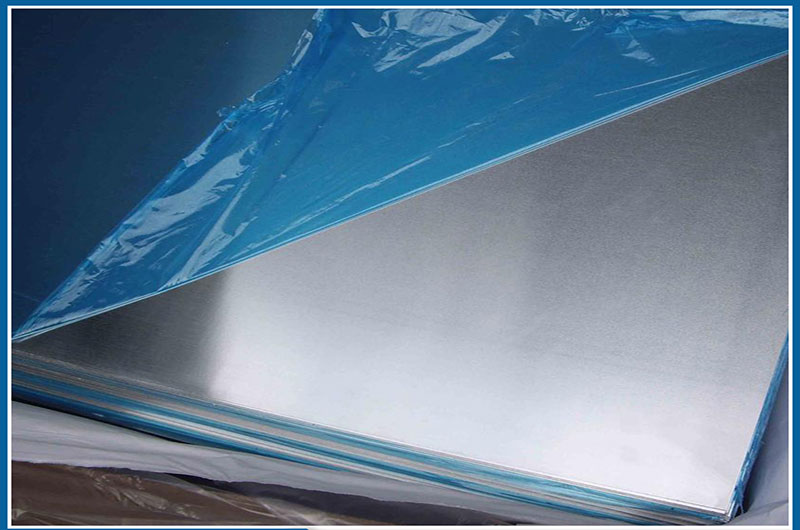
Aluminum Plate 5086 Specifications
Alloy 5086 Commonly Used Temper
H32: Strain hardened and steady state, offering a good balance of strength, shape, and corrosion resistance.
- 5086 O Aluminum Plate
- 5086 H112 Aluminum Plate
- 5086 H116 Aluminum Plate
- 5086 H111 Aluminum Plate
- 5086 H321 Aluminum Plate
- 5086 H32 Aluminum Plate
- 5086 H36 Aluminum Plate
- 5086 H38 Aluminum Plate
-
5086 h32 Aluminum Plate Sheet
5086-H32 Aluminum is 5086 aluminum in the H32 condition. To achieve this state, the metal is strain-hardened and then stabilized to about one-fourth the strength between annealed (O) and fully hard (H38).
-
5086 h111 Aluminum Plate Sheet
5086 h111 Aluminum Plate Sheet conforms to industry standards and specifications, the material has a consistent thickness, stable performance, smooth surface, and no defects such as cracks, voids, or impurities.
-
5086 h116 Aluminum Plate Sheet
5086 h116 aluminum plate sheet complies with industry standards and specifications, with a smooth surface and no defects at competitive prices.
| Specification | Description |
|---|---|
| Width |
Available in various widths, e.g., 36 inches (914 mm) 5086 Aluminum Plate 48 inches (1219 mm) 5086 Aluminum Plate 60 inches (1524 mm) 5086 Aluminum Plate |
| Length |
Typically available in standard lengths, e.g., 96 inches (2438 mm) 5086 Aluminum Plate 120 inches (3048 mm) 5086 Aluminum Plate custom lengths may be available. |
| Surface Treatment Type |
- Mill Surface: Natural, untreated surface from the mill. - Pre-Painted: Painted with a protective or color finish. |
| Product Certification | Can be certified to industry standards like ASTM or AMS. |
| Production Standards |
Manufactured to meet specific production standards such as ASTM B209 and AMS 4017. |
5086 Aluminum Plate Typical Thickness
Available in a variety of thicknesses, usually measured in inches or millimeters. Common thicknesses include:
| Product | Thickness (Inches) | Thickness (Millimeters) |
|---|---|---|
| 5086 Aluminum Plate | 0.125 inches | 3.175 mm |
| 5086 Aluminum Plate | 0.190 inches | 4.826 mm |
| 5086 Aluminum Plate | 0.250 inches | 6.350 mm |
| 5086 Aluminum Plate | 0.375 inches | 9.525 mm |
| 5086 Aluminum Plate | 0.500 inches | 12.700 mm |

Aluminum 5086 Equivalent
- Aluminum 5086
- Alloy 5086
- UNS A95086 (Unified Numbering System)
- AA5086 (Aluminum Association designation)
- AlMg4
- AlMg4Mn
- AlMg4.5Mn0.7
- AlMg4.5Mn0.7-H32
5086 Aluminum Plate Mechanical Properties
Typical mechanical properties of aluminum sheet 5086 (H32 temper) include:
- Tensile Strength: 40, 000 psi (275 MPa)
- Yield Strength: 35, 000 psi (240 MPa)
- Elongation: 12% (in 2 inches)
- Hardness (Brinell): 83
5086 Aluminum Plate Chemical Composition (approximate percentages)
- Aluminum (AL): 94.7%
- Magnesium (mg): 4.0%
- Manganese (MN): 0.15%
- Chromium (CR): 0.05%
Typical Aluminum Alloy 5086
5086 H111 Aluminum Plate
H111 is a temperature designation that indicates that the alloy has undergone strain hardening and has been stabilized by low temperature heat treatment.
The H111 temper provides relatively soft and annealed conditions that make the material more formable.
It has medium strength and good corrosion resistance.
This temper is typically used in applications that require deep graphics or high volume formation, such as marine components and pressure vessels.
| Property | Value |
|---|---|
| Tensile Strength | 42, 000 psi (290 MPa) |
| Yield Strength | 21, 000 psi (145 MPa) |
| Elongation | 14% (in 2 inches) |
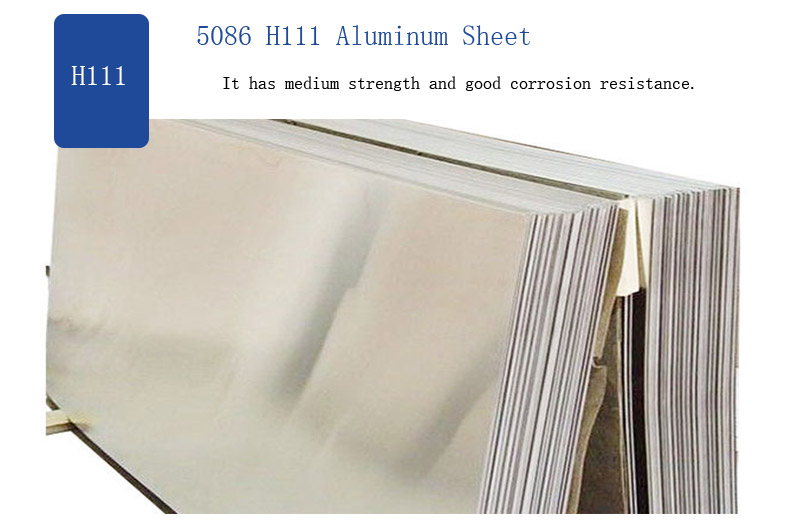
5086 H32 Aluminum Plate
H32 is a tempered designation representing strain hardening and stable conditions.
Compared with H111, H32 temper can provide higher strength while maintaining good formation.
It has excellent corrosion resistance, especially in marine environments.
This temper is widely used in marine applications, structural components, and the transportation industry where strength, performance, and corrosion resistance are critical.
| Property | Value |
|---|---|
| Tensile Strength | 45, 000 psi (310 MPa) |
| Yield Strength | 22, 000 psi (152 MPa) |
| Elongation | 12% (in 2 inches) |
5086 H116 Aluminum Plate
H116 is a temper designation indicating strain hardening and steady state, designed for high strength applications.
Compared to H32, the H116 temper can significantly increase the strength, while still maintaining good formation.
It has excellent corrosion resistance making it suitable for marine and offshore structures.
This temper is often used in heavy-duty applications that require higher strength, such as shipbuilding, offshore platforms, and pressure vessels.
| Property | Value |
|---|---|
| Tensile Strength | 47, 000 psi (324 MPa) |
| Yield Strength | 33, 000 psi (228 MPa) |
| Elongation | 10% (in 2 inches) |
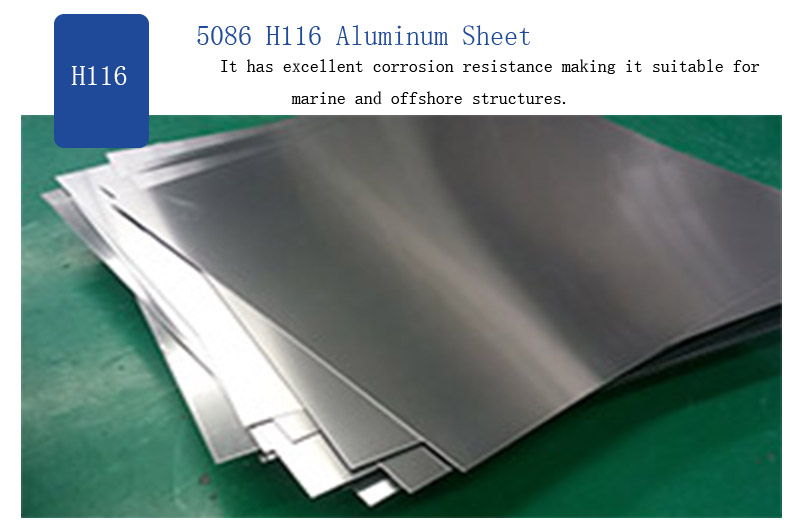
What is Aluminum 5086 Used for?
Application Areas: Due to its corrosion resistance and high strength, 5086 aluminum is commonly used in marine and naval applications such as hull hulls, superstructures, and offshore structures. It is also used to transport industrial components, pressure vessels, and cryogenic tanks.
- 5086 is the hull material of choice for small aluminum boats or larger yachts. Its high strength and good corrosion resistance make it an excellent match for yachts.
- 5086 is prone to stress corrosion cracking and is therefore rarely used in aircraft manufacturing.
- 5086 has been used in vehicle armor, specifically the M113 armored personnel carrier and the M2 Bradley infantry fighting vehicle.
Aluminum Alloy 5086 Marine Applications
One of the main uses of Aluminum 5086 is in the marine industry, due to its excellent corrosion resistance in saltwater environments, its high strength to weight ratio helps reduce the overall weight of marine vessels while maintaining structural integrity.
In marine applications, 6061 aluminum alloy can be combined with aluminum 5086.
Alloy 6061 is often used with Aluminum 5086 in marine applications where it has good corrosion resistance.
- 5086 alloy: used for hull, deck, and superstructure.
- 6061 alloy: used in conjunction with 5086 alloys for hardware, armrests, and interior parts.
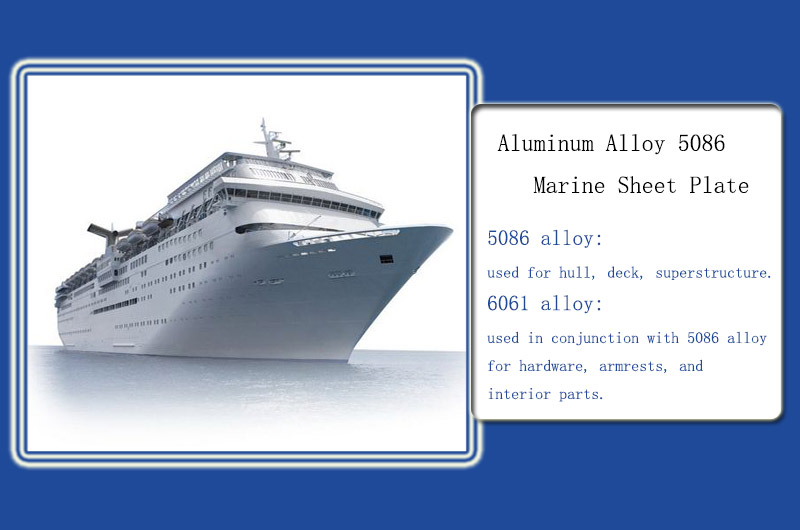
Offshore Structure
Aluminum 5086 is also used in offshore structures where it can withstand the rigors of saltwater and provide structural stability in offshore environments.
An example is an oil rig platform, where corrosion resistance and strength are critical.
Alloy 5456 is often used in combination with Aluminum 5086 for offshore structures where it has excellent corrosion resistance.
- Alloy 5086: Used in offshore structures and welded panels and pressure vessels.
- 5456 Alloy: It is used in conjunction with 5086 Alloy for welding panels and pressure vessels.
Aluminum Alloy 5086 for the Transportation Industry
Aluminum 5086 finds application in the transportation industry for vehicles requiring lightweight construction without compromising strength and durability. Its corrosion resistance ensures longevity in outdoor and road salt exposure.
Aluminum 5052 is commonly used with aluminum 5086 in the transportation industry, which has good shape and corrosion resistance, making it suitable for components such as truck bed floors and fuel tanks.
- Alloy 5086: Used in truck trailers, tankers, and other vehicles requiring lightweight construction and durability.
- Alloy 5052: Matches Alloy 5086 for components such as truck beds and fuel tanks.

Cryogenic Storage Tank
The excellent low temperature properties of Aluminum 5086 make it suitable for low temperature applications. It is used in the construction of cryogenic tanks and containers to store and transport liquefied gases such as liquid nitrogen and liquid oxygen.
- Alloy 5083: Aluminum 5083 is commonly used in cryogenic tanks along with Aluminum 5086, which provides excellent low temperature characteristics.
- Alloy 5086: Suitable for cryogenic tanks and vessels due to its cryogenic properties.
- 5083 alloy: It is used together with 5086 alloys for cryogenic storage tank components and linings.
Pressure Vessel
Aluminum 5086 is used in the manufacture of pressure vessels for a variety of industries including chemical processing, food processing, and oil and gas. Its corrosion resistance, combined with its high tensile strength, makes it a reliable choice for containing and transporting fluids under pressure.
Alloy 6061 is used in combination with Aluminum 5086 for pressure vessels. It provides good strength and weldability and is used for pressure vessel heads and fittings.
- Alloy 5086: Used in pressure vessel construction, including vessel shells and components.
- 6061 alloy: It is used together with 5086 alloys for pressure vessel heads and pipe fittings.
Heat Exchanger
Aluminum 5086 is suitable for heat exchangers in the marine, oil and gas, and industrial sectors. Its corrosion resistance and good thermal conductivity make it an effective material for transferring heat between fluids.
Aluminum 3003 is usually used together with aluminum 5086 for heat exchangers, it has good thermal conductivity and can be used for heat exchange tubes and fins.
Alloy 5086: Used in heat exchanger applications, including tubes, fins, and other heat transfer components.
3003 alloy: heat exchanger tubes and fins are matched with 5086 alloys.

Structural Application
Due to its high strength, Aluminum 5086 is used in structural applications where lightweight construction is required. It can be found in architecture and construction projects, bridges, and other architectural elements.
Overall, grade 5086 aluminum is a versatile alloy with a combination of strength, corrosion resistance, and weldability, making it suitable for a variety of applications requiring durability and performance in challenging environments.
Weight of 5086 Aluminum Plate
The weight of a 5086 aluminum plate depends on its thickness, dimensions, and density. Aluminum has a density of approximately 2.7 grams per cubic centimeter (g/cm³) or 0.0975 pounds per cubic inch (lb/in³). To calculate the weight of a 5086 aluminum plate, you'll need to know its dimensions (length, width, and thickness).
The formula to calculate the weight of an aluminum plate is:
Weight (in pounds) = Volume (in cubic inches) x Density (in lb/in³)
Here's an example calculation for a 5086 aluminum plate with the following dimensions:
- Length: 96 inches
- Width: 48 inches
- Thickness: 0.250 inches
First, calculate the volume:
- Volume = Length x Width x Thickness
- Volume = 96 in x 48 in x 0.250 in = 11, 520 cubic inches
Now, calculate the weight using the density of aluminum:
- Weight = Volume x Density
- Weight = 11, 520 in³ x 0.0975 lb/in³ ≈ 1, 123.2 pounds
So, a 5086 aluminum plate with these dimensions and thickness would weigh approximately 1, 123.2 pounds. Keep in mind that this is just an example, and the weight will vary depending on the specific dimensions and thickness of the plate.
5086 Aluminum Plate Supplier
- Product Quality: Conforming to industry standards and specifications, the material has a consistent thickness, and excellent surface finish, and is free of defects such as cracks, voids, or impurities.
- Certification and compliance: have relevant certifications such as ISO9001. Ensures that its production process meets established quality standards and is audited frequently.
- Complete product specifications: Diversified range of thickness and size to meet different customer needs. They should be able to provide custom linens if required.
- Customer Service: Excellent customer service with accurate product information, competitive pricing, and a willingness to resolve any questions or problems promptly.
- Packaging and Handling: To minimize the risk of damage, proper handling and storage procedures are in place to ensure the integrity of the product upon delivery.
5086 Aluminum Welding
5086 aluminum is considered weldable and can be successfully welded using a variety of welding methods.
Choose to match the composition of 5086 aluminum or to match a compatible filler material. Commonly used filler alloys for welding 5086 aluminum include 5356 and 5556.
How to Choose 5086 Aluminum Plate?
Choosing the right 5086 aluminum plate among the various temper conditions (5086 O, H112, H116, H111, H321, H32, H36, H38) depends on the specific requirements and needs of your project. Here are some factors to consider when making your choice:
1. Strength Requirements
Determine the intensity level required for your application.
- If high strength is required, consider H38 or H36.
- If medium intensity is sufficient, H111, H112, or H116 may be suitable.
2. Corrosion Resistance
Consider the environmental conditions to which the aluminum will be exposed.
- For excellent corrosion resistance, especially in marine environments, H116 is a good choice.
- H32 and H36 also have good corrosion resistance.
- H38 offers the highest level of corrosion resistance in the 5086 series.
3. Formability
Evaluate how easily your project will require the material to be shaped or molded.
- If extensive molding is required, consider O or H111, which offer good moldability.
- H32 and H36 also offer moderate formability.
4. Weldability
If your project involves welding, it is important to choose a temper that has good solderability.
- O, H32, H36, and H38 generally have good weldability.
- H111, H112, and H116 can be welded using appropriate techniques.
5. Processability
Evaluate whether the material needs to be machined. O and H32 tend to have better machinability than some other states.
6. Cost
Consider budget constraints, as some tempers may be easier to obtain or more cost-effective than others.
7. Specific applications
Different tempers are often used for specific applications.
- H116 is often chosen for use in ships and shipbuilding
- H321 is used in the construction of pressure vessels
Choosing the right 5086 aluminum plate requires balancing factors such as strength, corrosion resistance, formability, weldability, and cost, while also considering your application needs. Carefully evaluate your project requirements to make an informed choice among available 5086 temper conditions.
5086 Aluminum Plate vs 5052 Aluminum
1. Chemical Composition
- 5086 Aluminum: Primarily composed of aluminum (Al), magnesium (Mg), and manganese (Mn). It has a higher magnesium content than 5052 aluminum.
- 5052 Aluminum: Mainly composed of aluminum (Al), magnesium (Mg), and chromium (Cr).
2. Strength
- 5086 Aluminum: Generally has higher strength compared to 5052 aluminum, especially in the H32 and H116 temper conditions.
- 5052 Aluminum: Offers moderate strength, making it suitable for a wide range of applications.
3. Formability
- 5086 Aluminum: Exhibits good formability, allowing for various forming processes such as bending, shaping, and deep drawing.
- 5052 Aluminum: Has excellent formability, making it highly suitable for intricate forming and fabrication.
4. Corrosion Resistance
- 5086 Aluminum: Provides excellent corrosion resistance, particularly in marine environments, due to its high magnesium content.
- 5052 Aluminum: Offers good corrosion resistance, but not as high as 5086 aluminum, especially in saltwater or marine environments.
5. Common Applications
- 5086 Aluminum: Widely used in marine applications, such as boat hulls, decks, and superstructures, as well as offshore structures, pressure vessels, and cryogenic tanks.
- 5052 Aluminum: Commonly used in general sheet metal fabrication, automotive components, fuel tanks, and architectural applications.
People also searched for Aluminum Plate
-
5083 Aluminum Plate Sheet
5083 aluminum plate is a non-heat treatable alloy with high strength and corrosion resistance. We offer a wide range of sizes, thicknesses, and specifications at affordable prices to meet customer-specific needs.
-
5083 H32 Aluminum Plate Sheet
5083 H32 aluminum plate has excellent corrosion resistance, good weldability, and high strength. The surface of the 5083 h32 Aluminum Plate has no oil spots, no waves, no scratches, no roll marks, and meets the production standards.
-
5083 h111 Aluminum Plate Sheet
5083 aluminum is the strongest non-heat-treatable aluminum alloy. 5083 H111 aluminum is known for its superior performance in extreme environments, and 5083 O H111 sheet is used in marine and shipbuilding applications.
-
5083 h112 Aluminum Plate Sheet
5083 h1112 aluminum has very good corrosion resistance and medium strength, and it is very suitable for welding. 5083 h112 aluminum plate can be used in transportation, pressure vessels, cryogenic equipment, towers and drilling platforms, gas/oil pipelines, ordnance and armor plates.
-
5083 o Aluminum Plate Sheet
5083-O aluminum is 5083 aluminum in the annealed state. It has the highest ductility compared to other variants of 5083 aluminum.
-
5083 h116 Aluminum Plate Sheet
5083 H116 aluminum plate is often used in the marine field because of its high low-temperature strength and corrosion resistance, which can extend the service life of the ship. Because of its light weight, it can better increase the ship's speed.

